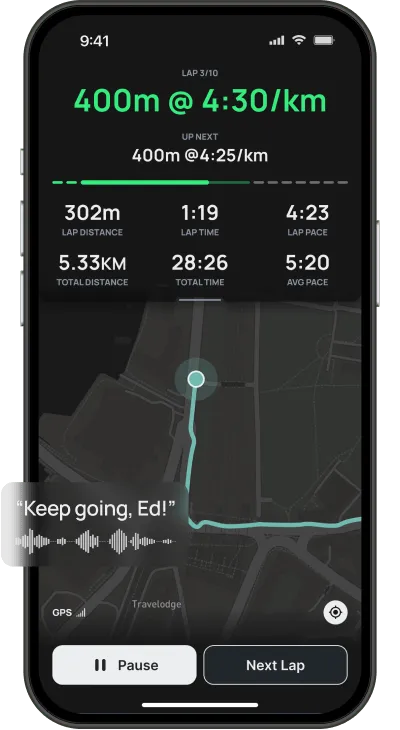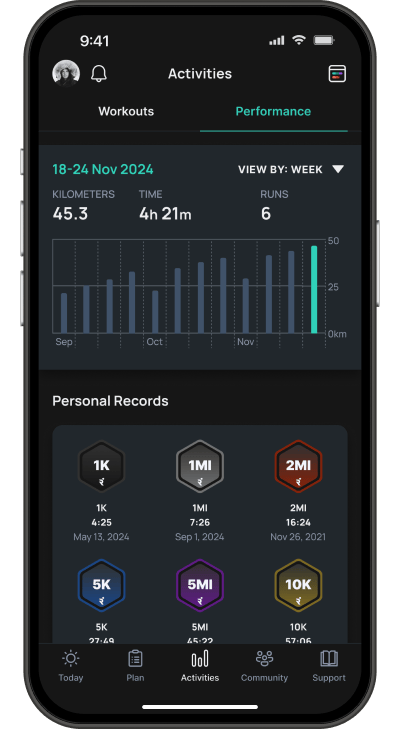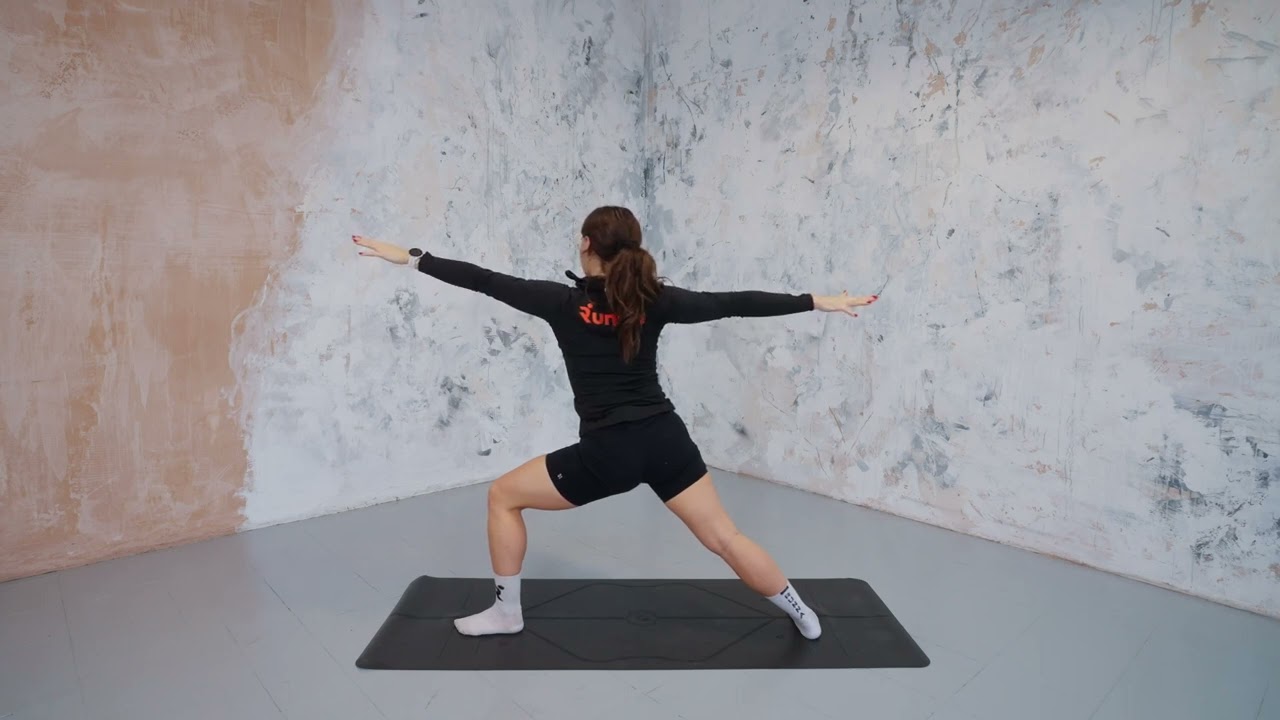Strength Training Plan
Strength training is the key to running better for longer. With the right plan, you’ll prevent injuries, run more efficiently, and unlock the power to hit your next goal.

Why do runners need strength training?
Running is a repetitive, high-impact sport. Every stride sends force through your muscles, tendons, and joints - and without the right conditioning, that stress can build into fatigue or injury. Strength training gives your body the tools to handle those loads, making you a more efficient, resilient runner.
The benefits go well beyond injury prevention. Stronger glutes and hamstrings drive you forward with more power, while calves and Achilles tendons absorb impact and return energy with each step. A stable core supports your posture and keeps your form strong, even when you’re tired. Strength work also develops smaller stabilizing muscles around the hips, knees, and ankles - the ones often overlooked until they cause problems - helping you stay balanced and protected.
For endurance athletes, strength training builds durability. By progressively overloading muscles in controlled sessions, you prepare them to handle higher mileage, long runs, and tougher workouts. And because it also improves balance and coordination, you’re less likely to trip, misstep, or lose form when fatigue sets in.
Just 1–2 well-structured sessions each week can make you feel stronger, more efficient, and more confident every time you hit the road or trail.

Why choose our strength training plan?
Whatever your experience or goal, we’ll give you everything you need to get there.
How to get started
Runna turns strength training into a clear path forward - no confusion, just structured sessions that transform how you run and recover.
Choose your plan
Pick your running goal and we’ll add the strength work that supports it, tailored to your level, lifestyle, and equipment.
Download the app
Download the app, log in and your strength sessions, demo videos, and recovery tips will all be at your fingertips.
Run, run, run!
Simply tap ‘Go’ and follow along. Every session is laid out clearly, so you always know exactly what to do.
Hit that goal
Stay consistent and you’ll build resilience, power, and efficiency that translates directly into stronger running.
Workouts explained
Your strength training plan combines different workouts - here’s how each one builds the specific strength and stability you need to run your best.
Tips for your strength training plan
These expert-backed tips will help you train smarter, avoid injury, and stay motivated. From progression and recovery to gear and mindset, discover just a small snippet of all the tips, nutrition and coaching advice you'll have at your fingertips with a Runna training plan.
Nutrition
Strength training challenges your body in different ways than running, and nutrition is what turns that effort into results.
- Protein is essential: it repairs and strengthens the muscles you load in every session. Aim for a high-quality source like lean meat, fish, eggs, dairy, or plant-based proteins in every meal, and prioritize it within an hour of training when your muscles are primed for recovery.
- Carbohydrates fuel both your runs and lifts. They allow you to hit higher-quality sessions, maintain energy across sets, and recover glycogen stores after. Focus on complex carbs like oats, rice, whole grains, and starchy vegetables, while using quick sugars before or during tougher efforts for an immediate boost.
- Healthy fats - from avocado, nuts, seeds, and olive oil - play a key role in joint health, hormone regulation, and reducing inflammation, all of which keep you resilient across training blocks.
- Hydration ties it together: even mild dehydration impairs muscle contractions and focus, so sip consistently through the day.
Think of food as both fuel and recovery. The right balance helps you train harder, bounce back quicker, and keep building strength week after week.
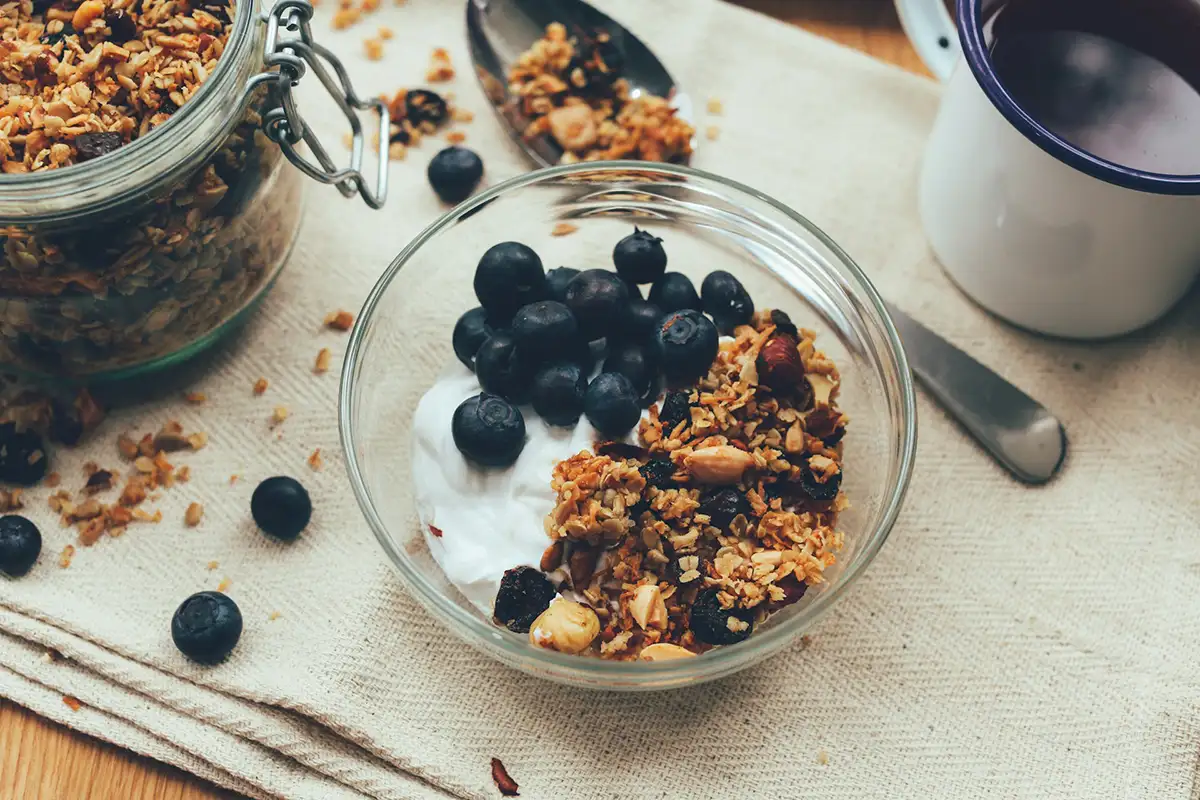
Balancing strength and running
Balancing your lifting with your running is all about energy management. Every hard workout - whether on the track or in the gym - creates stress your body needs time to adapt to. Stack too many demanding sessions together, and recovery suffers. Spread them smartly, and each discipline makes the other stronger.
The key is to match intensity to purpose. Heavy lifting pairs best with easy run days, while quality run sessions should have lighter or mobility-focused strength alongside them. This ensures you can push hard where it counts without compromising performance in either area.
Your weekly mileage and experience also matter. Higher-volume runners often need fewer, shorter strength sessions, while those running less can lean on strength training to build resilience and fitness.
Runna takes the guesswork out of this balance. Your plan is structured so runs and lifts complement - not compete - ensuring you train smarter and unlock new levels of performance.

Progression
Unlike running, where progress is often measured by pace, strength training is all about progression - gradually increasing the challenge so your body keeps adapting. Without progression, you risk hitting a plateau.
This doesn’t just mean lifting heavier. Progression can look like more reps, slower tempos, more challenging variations, or shifting from bodyweight to added resistance. Each small step makes your muscles, tendons, and joints more resilient.
Form always comes first. Perfect your technique with lighter loads before adding weight. Once you’re confident, aim for 85–95% of your maximum effort for the reps prescribed. For example, if you’re asked to do 8 reps, pick a weight you could manage 10–12 with. This builds strength without leaving you too sore to run the next day.
Progression is about smart, steady gains - not ego lifting. The goal isn’t to max out once, it’s to stay consistent and get stronger over months of training.

Form
Every rep is practice, and form is what makes it count. Correct technique ensures the right muscles are targeted, protects your joints, and builds strength that directly carries into better running mechanics.
Why it matters: Good form stabilizes joints, prevents energy leaks, and makes training safer and more efficient. A controlled lunge, for example, strengthens hip stability - the same control that prevents knee collapse during a run.
What to focus on: Keep a neutral spine, shoulders relaxed, and core braced. Knees should track over toes, and movements should be smooth, not rushed.
How to improve: Start with bodyweight, master alignment, then add resistance. Use mirrors, demo videos, or Runna’s in-app cues to catch and correct small errors before they become habits.
Remember: Quality always beats quantity. Ten precise reps will build more lasting strength than twenty sloppy ones.

Recovery
Strength gains happen between sessions. Training breaks down muscle fibers - recovery rebuilds them stronger and more resilient.
- Sleep: Aim for 7–9 hours per night. This is when muscles repair, hormones rebalance, and adaptations lock in.
- Mobility work: Add yoga, Pilates, or stretching to maintain flexibility and offset the stiffness that can build up from lifting.
- Massage and tools: Use a foam roller, massage gun, or occasional sports massage to ease tightness and keep muscles moving freely.
- Nutrition and hydration: Refuel after workouts with a mix of protein (for muscle repair) and carbs (to replenish glycogen). Hydrate consistently throughout the day, not just post-session.
- Active recovery: Low-intensity movement - like walking, cycling, or swimming - boosts circulation and reduces soreness without adding stress.
- Flexibility: Listen to your body. If fatigue or soreness lingers, scale back or take an extra day off. Consistency over months builds more strength than pushing through and risking injury.
Treat recovery as part of your training, not separate from it. Every rest day is an investment in your next stronger, safer session.

Gear
You don’t need a full gym to see results. Consistency and good form matter more than fancy equipment.
Many runners start with bodyweight exercises - squats, lunges, planks, and push-ups - which build a solid foundation and teach good form before adding load. From there, equipment can expand your training options:
- Resistance bands: Perfect for activating glutes, hips, and other smaller stabilizers that protect your joints.
- Dumbbells & kettlebells: Compact, versatile, and ideal for progressing both upper and lower body strength.
- Barbells & benches: The go-to for building maximum strength and power, especially with compound lifts like squats or deadlifts.
- Other tools: Swiss balls, boxes, or pull-up bars add variety and challenge your balance, coordination, and core stability.
Start with what you’ve got. Runna adapts your plan around your available equipment, so every workout feels achievable and effective.
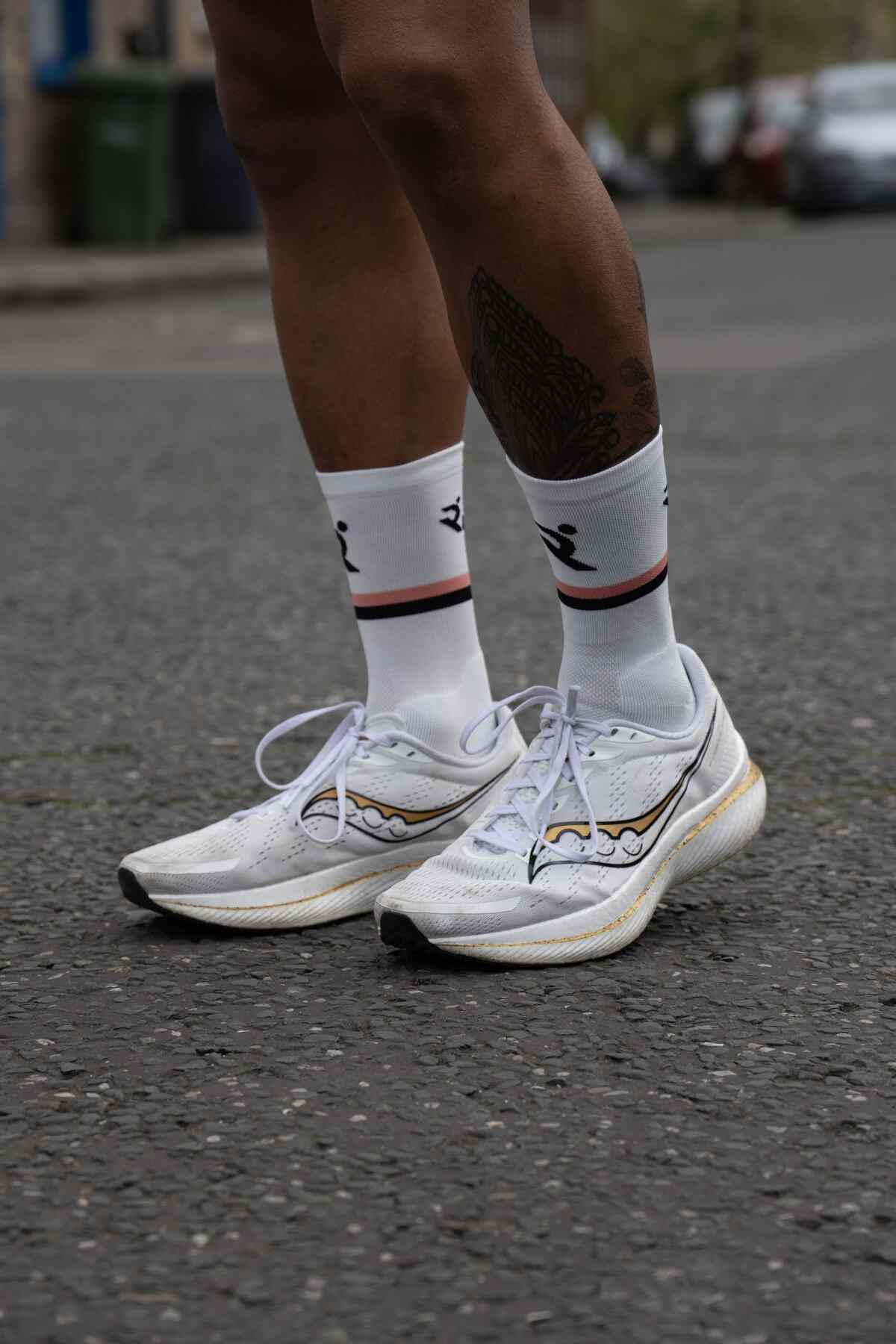
As featured in




Stories from Runnas
FAQs: All you need to know about strength training
What kind of strength training should runners do?
Focus on exercises that target multiple muscle groups, such as squats, lunges, and deadlifts. Use core strengthening exercises like planks and rotational movements to improve stability and performance.
How many times a week should a runner do strength training?
More is not always better. Start with once more than what you’re currently doing, and up to 3-4 times a week. If you aren’t doing any strength training for now, start with once a week and build on that as you go.
Should runners lift heavy or light?
You can do both – heavy lifting at lower reps helps build strength, while lighter weights at more reps help improve endurance.
To reduce the risk of muscle soreness (and be able to run in the next few days!), aim to add more weight progressively and stay at 85-95% of your maximum effort.
Should runners lift for strength or endurance?
You can do both. Strength training with heavier weights helps increase power and speed, while endurance lifting with lighter weights for more reps improves muscular stamina and running efficiency.
Should I stretch every day as a runner?
Daily stretching can help you maintain flexibility and range of movement – and therefore decreases the risk of injuries. Focus on dynamic stretches before runs to warm up muscles, and static stretches after runs to improve flexibility and reduce muscle tightness.
When should runners do leg day?
Allow for recovery after leg day. This means that you should schedule it ideally 2-3 days before a long run or speed work – and more, if you have a race coming up.
This timing helps maintain leg strength without compromising performance on your more challenging running sessions.
Inspiration

Everything you Need to Know About Strength Training for Runners
It's no secret that as well as helping to reduce injury risk, strength training can also increase performance too - we'll cover why.

Choosing Your Strength Goal and Training Frequency
Select a strength goal to build a strength training plan tailored to your personal goals. Both options will help you with your running, however, each has its own benefits.
.jpg)
Introduction to Mobility Training for Runners
Mobility training can help aid recovery and enhance your range of motion to help improve your running performance - here's why.



